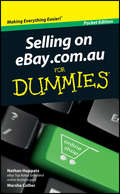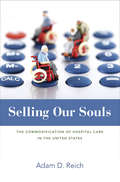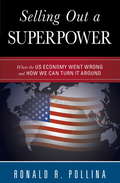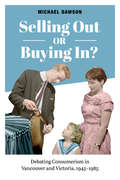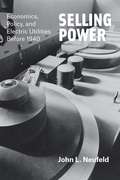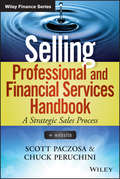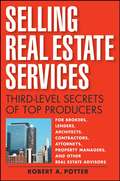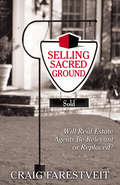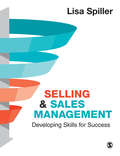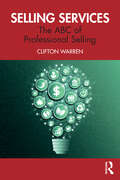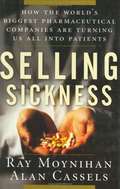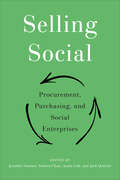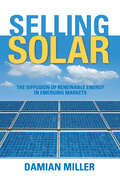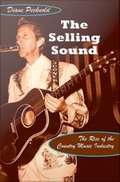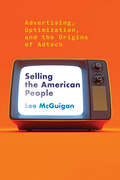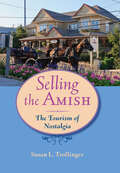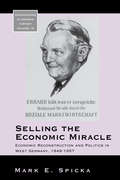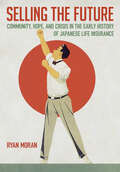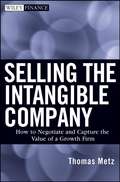- Table View
- List View
Selling On eBay.com.au For Dummies
by Nathan Huppatz Marsha CollierClear the clutter and make some cash! Selling items on eBay.com.au is the perfect way to declutter your home and make some money in the process. But getting the best price for your items isn’t always a cinch. This book provides plenty of tips and tricks for improving your listings, using the most suitable (and cost-effective) shipping methods, setting up an eBay store, using pictures to increase your profits, and finding more goods to sell.
Selling Our Souls: The Commodification of Hospital Care in the United States
by Adam Dalton ReichHealth care costs make up nearly a fifth of U.S. gross domestic product, but health care is a peculiar thing to buy and sell. Both a scarce resource and a basic need, it involves physical and emotional vulnerability and at the same time it operates as big business. Patients have little choice but to trust those who provide them care, but even those providers confront a great deal of medical uncertainty about the services they offer. Selling Our Souls looks at the contradictions inherent in one particular health care market—hospital care. Based on extensive interviews and observations across the three hospitals of one California city, the book explores the tensions embedded in the market for hospital care, how different hospitals manage these tensions, the historical trajectories driving disparities in contemporary hospital practice, and the perils and possibilities of various models of care.As Adam Reich shows, the book's three featured hospitals could not be more different in background or contemporary practice. PubliCare was founded in the late nineteenth century as an almshouse in order to address the needs of the destitute. HolyCare was founded by an order of nuns in the mid-twentieth century, offering spiritual comfort to the paying patient. And GroupCare was founded in the late twentieth century to rationalize and economize care for middle-class patients and their employers. Reich explains how these legacies play out today in terms of the hospitals' different responses to similar market pressures, and the varieties of care that result.Selling Our Souls is an in-depth investigation into how hospital organizations and the people who work in them make sense of and respond to the modern health care market.
Selling Out a Superpower
by Ronald R. PollinaIn 1968, there were sixty-two lobbyists in Washington; today there are thirty-four thousand, outnumbering members of Congress and their staffers two to one. By 2008, these lobbyists were spending approximately $8.2 million for influence per day. Few, if any, of these lobbyists represent the majority of Americans in the middle class. So it's not surprising, given these statistics, that real median household income in America has stagnated for over a decade. This hard-hitting book documents that a combination of special interest groups and their army of money-peddling lobbyists, along with government mismanagement of business and the economy by both parties, have betrayed the American middle and lower classes for the last twenty years. The result is a host of misguided laws and policies that have driven jobs and whole industries offshore, never to return. The author takes issue with those who emphasize the potential benefits of globalization without taking notice of its many negative effects on American society. He also argues that inept policy threatens to derail the American economy permanently and that our economic malaise is more than a short-term reaction to a financial market collapse or global market forces. He cites critical areas where changes must be made to reverse the negative trend:* Improving our 1950s-era educational system to produce a workforce able to compete for 21st-century jobs.* Reform of tax codes that have been driving companies and jobs offshore. We are currently a nation that manufactures practically nothing!* Weaning all levels of government away from deficit spending, which drains economic power* Pursuing free trade that also means fair trade.* Ending the cycle of credit-card debt and all-too-easy mortgage credit to finance ultimately unaffordable lifestyles.* Making the United States more business friendly, so companies will grow and provide desperately needed jobs here at home.The author warns that unless we implement these and other recommended changes, the American economy will inevitably decline while China, India, and other up-and-coming nations ascend. He maintains that all is not lost. If we follow the course he sets, we can reinvigorate and renew our economy, rebuild America's greatness, create 21st-century jobs, and more. This book provides a roadmap for reclaiming American preeminence.
Selling Out or Buying In?: Debating Consumerism in Vancouver and Victoria, 1945-1985
by Michael DawsonUntil the late 1950s residents of Vancouver and Victoria negotiated a shopping landscape that would be unrecognizable to today’s consumers: most stores were closed for at least half the day on Wednesdays, prevented from opening during the evenings, and were banned from operating on Sundays. Since that decade, however, British Columbians, and Canadians generally, have made significant strides in gaining greater and easier access to consumer goods. Selling Out or Buying In? is the first work to illuminate the process by which consumers’ access to goods and services was liberalized and deregulated in Canada in the second half of the twentieth century. Michael Dawson’s engagingly written and detailed exploration of the debates amongst everyday citizens and politicians regarding the pros and cons of expanding shopping opportunities, challenges the assumption of inevitability surrounding Canada’s emergence as a consumer society. The expansion of store hours was a highly contested and contingent development that pitted employees, owners and regulators against one another. Dawson’s nuanced analysis of archival and newspaper sources reveals the strains that modern capitalism imparted upon the accepted and established rhythms of daily life.
Selling Paris: Property and Commercial Culture in the Fin-de-siècle Capital
by Alexia M. YatesBesieged during the Franco-Prussian War, its buildings damaged, its finances mired in debt, Paris was a city in crisis. Alexia Yates chronicles the private actors and networks, practices and politics, that spurred the largest building boom of the nineteenth century, turning city-making into big business in the French capital.
Selling Power: Economics, Policy, and Electric Utilities Before 1940
by John L. NeufeldWe remember Thomas Edison as the inventor of the incandescent light bulb, but he deserves credit for something much larger, an even more singular invention that profoundly changed the way the world works: the modern electric utility industry. Edison's light bulb was the first to work within a system where a utility generated electricity and distributed it to customers for lighting. The story of how electric utilities went within one generation from prototype to an indispensable part of most Americans' lives is a story about the relationships between political and technological change. John L. Neufeld offers a comprehensive historical treatment of the economics that shaped electric utilities. Compared with most industries, the organization of the electric utility industry is not--and cannot be--economically efficient. Most industries are kept by law in a state of fair competition, but the capital necessary to start an electric company--generators, transmission and distribution systems, and land and buildings--is so substantial that few companies can enter the market and compete. Therefore, the natural state of the electric utility industry since its inception has been a monopoly subject to government oversight. These characteristics of electric utilities--and electricity's importance--have created over time sharp political controversies, and changing public policies have dramatically changed the industry's structure to an extent matched by few other industries. Neufeld outlines the struggles that shaped the industry's development, and shows how the experience of electric utilities provides insight into the design of economic institutions, including today's new large-scale markets.
Selling Professional and Financial Services Handbook + Website
by Scott Paczosa Chuck PeruchiniAn effective strategic framework for successful face-to-face selling for financial services industry professionalsTimes are very tough for people who sell professional services and Selling Professional and Financial Services Handbook offers a new solution proven in practice. The book describes methods the authors have used and taught since the 1990s, most recently at a major consulting firm, where they led a Global Business Development team to revenue gains of 500% over six years -- in a period that included the recession of 2008-10.The solution is not any new twist on face-to-face selling techniques or the art of persuasion. It's a strategic approach built around a simple fact: the markets are tight but far from static. Even with lean budgets, client companies must respond to urgent changes and emerging threats in their industries. Thus they will buy services from the sellers who can help them detect, understand, and cope with what's coming their way.This handbook outlines a systematic way of becoming such a valued resource. Readers learn to scan the horizon for early signs of "rock-ripple events." Major changes in the business world often spring from new developments that are little noted or heeded, at first, by the client companies soon to be affected by them. But like a rock dropped in a pond, these events set off ripples that sweep through entire industry sectors, creating must-have service needs.The book is written for everyone who sells, or is responsible for selling, professional services. This includes but is not limited to: law firms, consulting firms, finance industry, public relations, engineering, and architectural services.Readers who can benefit from the dynamic approach hold a variety of positions. They include:Attorneys, consultants and other practitioners who must sell their services as well as execute.CEOs, equity partners, practice-area leaders, functional and divisional leadersPrivate Equity or Venture Capital executivesSales or business-development professionals, from entry level to senior levelSales and marketing managersBut the book is for sellers in every category who need a new and better approach to selling. Many, even the most skilled, simply have not adjusted to the new normal of today's economy. They persist with old strategies that cannot be as productive as they once were, such as pursuing one-off opportunities (which are too few and too hard to win in lean times) or old-style "relationship selling" (which gains little if any traction). Selling Professional and Financial Services Handbook gives all such readers a new strategic framework within which to apply their face-to-face selling skills. It is an approach that puts them in position to win -- so they can sell from ahead of the game, instead of struggling to keep up with it.
Selling Real Estate Services
by Robert A PotterPraise for Selling Real Estate Services"Selling Real Estate Services shows you how to stop being a vendor and start being a partner. Bob Potter's Third-Level concept will help you win more, have more fun, and build greater client loyalty. It's a playbook for success."--Roger T. Staubach, Executive Chairman for the Americas, Jones Lang LaSalle, and founder of The Staubach Company"It's not just about selling; it's about winning. Just in time for one of the most competitive markets in a generation. Be prepared to win."--Robert A. Ortiz, Executive Managing Director - U.S. Operations, Cushman & Wakefield Inc."Bob Potter's Third-Level Selling offers a progressive, advanced approach to building trust, demonstrating value, and winning. Whether you are new to real estate or a seasoned veteran, it will take your career to the next level."--Craig Robbins, Chief Knowledge Officer, Colliers International"Business development never stops for successful real estate companies. Bob Potter gets it, and his simple strategies and techniques can be implemented immediately across a sales-oriented organization. This book is a gem."--Tom Donnelly, President and COO, ValleyCrest Landscape Development"Rarely do books capture the essence of success in our industry. Third-Level Selling helps one understand how you build long-term committed relationships with clients. This book is a road map to becoming a top producer; I only hope that my competition doesn't read it!"--Dan Winey, Managing Principal, Gensler
Selling Sacred Ground: Will Real Estate Agents Be Relevant or Replaces?
by Craig FarestveitSelling Sacred Ground takes an in-depth look at the real estate sales process and whether or not the real estate agent will be relevant or worthy of replacement in the marketplace.With over 5 million homes selling in the US every year, our growing DIY culture is asking if the traditional real estate agent is worth the commissions paid in all of those transactions. After all, traditional &“experts&” such as travel agents, stock brokers, and even doctors have been forced to adjust their roles with sites such as Expedia, Charles Schwab, and WebMD available to the public.Whereas most real estate resources are focused on how to get more clients and even more money from those clients, long-term veteran Craig Farestveit addresses how to actually do the job well for clients. A sobering how-to for those considering a career in real estate, Selling Sacred Ground looks at what a good real estate agent actually does in the sale of the home, helping those buying or selling decide if an agent is worth the cost and guiding experienced real estate agents to growth in a changing marketplace.
Selling & Sales Management: Developing Skills for Success
by Lisa SpillerPacked with engaging examples and case studies from companies including Amazon, IBM, and Pepsi, as well as unique insights from sales professionals across the globe, this comprehensive textbook balances research, theory, and practice to guide students through the art and science of selling in a fast-changing and digital age. The text highlights the emerging role of storytelling, sales analytics and automation in a highly competitive and technological world, and includes exercises and role plays for students to practice as they learn about each stage of the selling process. As well as its focus on selling, the text also provides students with essential sales management skills such as onboarding, coaching, mentoring, and leading salespeople, as well as managing sales pipelines, territories, budgets, systems, and teams when not in the field. Online resources are included to help instructors teaching with the textbook, including PowerPoint slides and a testbank. Chapter overviews and teaching notes for the roleplays included in the text and suggested course projects and worksheets are also provided for instructors. Suitable for courses on selling and sales management at all college and university levels.
Selling & Sales Management: Developing Skills for Success
by Lisa SpillerPacked with engaging examples and case studies from companies including Amazon, IBM, and Pepsi, as well as unique insights from sales professionals across the globe, this comprehensive textbook balances research, theory, and practice to guide students through the art and science of selling in a fast-changing and digital age. The text highlights the emerging role of storytelling, sales analytics and automation in a highly competitive and technological world, and includes exercises and role plays for students to practice as they learn about each stage of the selling process. As well as its focus on selling, the text also provides students with essential sales management skills such as onboarding, coaching, mentoring, and leading salespeople, as well as managing sales pipelines, territories, budgets, systems, and teams when not in the field. Online resources are included to help instructors teaching with the textbook, including PowerPoint slides and a testbank. Chapter overviews and teaching notes for the roleplays included in the text and suggested course projects and worksheets are also provided for instructors. Suitable for courses on selling and sales management at all college and university levels.
Selling Services: The ABC of Professional Selling
by Clifton WarrenMore than ever, our economy relies on the service industries – but selling services is far different from selling tangible products. This book demystifies the selling of intangibles and teaches the required skills to grow any professional service business. Leveraging his 30 years’ experience, leading sales expert Clifton Warren offers 26 lessons to help readers navigate the selling of complex and intangible solutions. Each chapter covers an important concept from A (Accountability) to Z (Zigzagging) in a concise and readable format, including a "to-do" action list that makes the book both a workbook and a study guide. By successfully applying the steps discussed in each chapter, professionals will substantially improve their performance and results, and anyone looking to drill down into specific topics will find additional resources to explore. B2B sales professionals in banking, insurance, finance, and other services, and small business owners such as lawyers, architects, and engineers, as well as professionals transitioning into sales roles, will appreciate the thorough and easy-to-follow guidance that this book provides.
Selling Sickness: How the World's Biggest Pharmaceutical Companies Are Turning Us All Into Patients
by Ray Moynihan Alan CasselsThis book presents a valuable counterweight to the mind-numbing barrage of unproven diagnoses and just plain dysinformation that haunts the airwaves and even some medical journals.
Selling Social: Procurement, Purchasing, and Social Enterprises
by Jennifer Sumner Andrea Chan Annie Luk Jack QuarterSince the 2010s, all levels of governments in Canada have gradually initiated social procurement as a policy tool to further their social values and political agendas. Social enterprises of various shapes and sizes across the country have served as partners in the execution of those agendas. Selling Social examines the experiences of these enterprises in social procurement and social purchasing. Selling Social presents the findings of a three-year Canadian research project detailing experiences of work integration social enterprises (WISEs) selling their goods and services to organizational purchasers, including governments, businesses, and non-profit organizations. Drawing on survey findings and interviews, the book explores a diverse group of social enterprises from across Canada, showcasing their successes and their challenges based on real-life examples to aid social enterprises that are considering this path. The book emphasizes the importance of including social and environmental considerations in procurement and purchasing decisions, particularly at larger scales and through public policy. In doing so, Selling Social extends the understanding of social enterprises beyond their social and economic outcomes and into the broader movement towards responsible procurement and purchasing.
Selling Solar: The Diffusion of Renewable Energy in Emerging Markets
by Damian MillerTo solve the climate crisis, the world must make a wholesale shift to renewable energy technologies. With surging growth in emerging markets, this transformation takes on even greater urgency. The challenges - and opportunities - are immense. Selling Solar considers how such a shift might happen. Focusing on the case of solar photovoltaics, it shows how, at the start of the 21st century, this promising technology began to diffuse rapidly in select emerging markets, after years of struggling to take off. What were the initial barriers to diffusion? How were they overcome? Who did it? And how can this success be replicated? Drawing on literature on innovation diffusion and entrepreneurship, the author answers these questions, showing how entrepreneurs affected profound technological change not just through the solar systems they sold, but through the example they set to both new market entrants and policymakers. In analysing how this happened, this book offers important lessons for the diffusion of a range of renewable energy technologies in emerging markets, and for the advancement of the sector as a whole. Selling Solar is essential reading for anyone who believes in a renewable energy future and wants it sooner rather than later.
The Selling Sound: The Rise of the Country Music Industry
by Diane PecknoldFew expressions of popular culture have been shaped as profoundly by the relationship between commercialism and authenticity as country music has. While its apparent realism, sincerity, and frank depictions of everyday life are country's most obvious stylistic hallmarks, Diane Pecknold demonstrates that commercialism has been just as powerful a cultural narrative in its development. Listeners have long been deeply invested in the "business side" of country. When fans complained in the mid-1950s about elite control of the mass media, or when they expressed their gratitude that the Country Music Hall of Fame served as a physical symbol of the industry's power, they engaged directly with the commercial apparatus surrounding country music, not with particular songs or stars. In The Selling Sound, Pecknold explores how country music's commercialism, widely acknowledged but largely unexamined, has affected the way it is produced, the way it is received by fans and critics, and the way it is valued within the American cultural hierarchy. Pecknold draws on sources as diverse as radio advertising journals, fan magazines, Hollywood films, and interviews with industry insiders. Her sweeping social history encompasses the genre's early days as an adjunct of radio advertising in the 1920s, the friction between Billboard and more genre-oriented trade papers over generating the rankings that shaped radio play lists, the establishment of the Country Music Association, and the influence of rock 'n' roll on the trend toward single-genre radio stations. Tracing the rise of a large and influential network of country fan clubs, Pecknold highlights the significant promotional responsibilities assumed by club organizers until the early 1970s, when many of their tasks were taken over by professional publicists.
Selling Sounds: The Commercial Revolution in American Music
by David SuismanFrom Tin Pan Alley to grand opera, player-pianos to phonograph records, David Suisman's Selling Sounds explores the rise of music as big business and the creation of a radically new musical culture. Around the turn of the twentieth century, music entrepreneurs laid the foundation for today's vast industry, with new products, technologies, and commercial strategies to incorporate music into the daily rhythm of modern life. Popular songs filled the air with a new kind of musical pleasure, phonographs brought opera into the parlor, and celebrity performers like Enrico Caruso captivated the imagination of consumers from coast to coast. Selling Sounds uncovers the origins of the culture industry in music and chronicles how music ignited an auditory explosion that penetrated all aspects of society. It maps the growth of the music business across the social landscape -- in homes, theaters, department stores, schools -- and analyzes the effect of this development on everything from copyright law to the sensory environment. While music came to resemble other consumer goods, its distinct properties as sound ensured that its commercial growth and social impact would remain unique. Today, the music that surrounds us -- from iPods to ring tones to Muzak -- accompanies us everywhere from airports to grocery stores. The roots of this modern culture lie in the business of popular song, player-pianos, and phonographs of a century ago. Provocative, original, and lucidly written, Selling Sounds reveals the commercial architecture of America's musical life.
Selling Sustainability Short?: The Private Governance of Labor and the Environment in the Coffee Sector (Organizations and the Natural Environment)
by Janina GrabsCan private standards bring about more sustainable production practices? This question is of interest to conscientious consumers, academics studying the effectiveness of private regulation, and corporate social responsibility practitioners alike. Grabs provides an answer by combining an impact evaluation of 1,900 farmers with rich qualitative evidence from the coffee sectors of Honduras, Colombia and Costa Rica. Identifying an institutional design dilemma that private sustainability standards encounter as they scale up, this book shows how this dilemma plays out in the coffee industry. It highlights how the erosion of price premiums and the adaptation to buyers' preferences have curtailed standards' effectiveness in promoting sustainable practices that create economic opportunity costs for farmers, such as agroforestry or agroecology. It also provides a voice for coffee producers and value chain members to explain why the current system is failing in its mission to provide environmental, social, and economic co-benefits, and what changes are necessary to do better.
Selling Textiles in the Long Eighteenth Century
by Jon Stobart Bruno BlondéTextiles are a key component of the industrial and consumer revolutions, yet we lack a coherent picture of how the marketing of textiles varied across the long 18th century and between different regions. This book provides important new insights into the ways in which changes in the supply of textiles related to shifting patterns of demand.
Selling the American People: Advertising, Optimization, and the Origins of Adtech
by Lee McGuiganHow marketers learned to dream of optimization and speak in the idiom of management science well before the widespread use of the Internet.Algorithms, data extraction, digital marketers monetizing "eyeballs": these all seem like such recent features of our lives. And yet, Lee McGuigan tells us in this eye-opening book, digital advertising was well underway before the widespread use of the Internet. Explaining how marketers have brandished the tools of automation and management science to exploit new profit opportunities, Selling the American People traces data-driven surveillance all the way back to the 1950s, when the computerization of the advertising business began to blend science, technology, and calculative cultures in an ideology of optimization. With that ideology came adtech, a major infrastructure of digital capitalism.To help make sense of today's attention merchants and choice architects, McGuigan explores a few key questions: How did technical experts working at the intersection of data processing and management sciences come to command the center of gravity in the advertising and media industries? How did their ambition to remake marketing through mathematical optimization shape and reflect developments in digital technology? In short, where did adtech come from, and how did data-driven marketing come to mediate the daily encounters of people, products, and public spheres? His answers show how the advertising industry's efforts to bend information technologies toward its dream of efficiency and rational management helped to make "surveillance capitalism" one of the defining experiences of public life.
Selling the Amish: The Tourism of Nostalgia (Young Center Books in Anabaptist and Pietist Studies)
by Susan L. TrollingerMore than 19 million tourists flock to Amish Country each year, drawn by the opportunity to glimpse "a better time" and the quaint beauty of picturesque farmland and handcrafted quilts. What they may find, however, are elaborately themed town centers, outlet malls, or even a water park. Susan L. Trollinger explores this puzzling incongruity, showing that Amish tourism is anything but plain and simple.Selling the Amish takes readers on a virtual tour of three such tourist destinations in Ohio’s Amish Country, the world’s largest Amish settlement. Trollinger examines the visual rhetoric of these uniquely themed places—their architecture, interior decor, even their merchandise and souvenirs—and explains how these features create a setting and a story that brings tourists back year after year.This compelling story is, Trollinger argues, in part legitimized by the Amish themselves. To Americans faced with anxieties about modern life, being near the Amish way of life is comforting. The Amish seem to have escaped the rush of contemporary life, the confusion of gender relations, and the loss of ethnic heritage. While the Amish way supports the idealized experience of these tourist destinations, it also raises powerful questions. Tourists may want a life uncomplicated by technology, but would they be willing to drive around in horse-drawn buggies in order to achieve it?Trollinger's answers to important questions in her fascinating study of Amish Country tourism are sure to challenge readers’ understanding of this surprising cultural phenomenon.
Selling the Dream: How to Promote Your Product, Company, or Ideas - And Make A Difference - Using Everyday Evangelism
by Guy KawasakiFormer product manager for Apple Computers, Guy Kawasaki, discusses a new selling technique he names "evangelism."
Selling the Economic Miracle: Economic Reconstruction and Politics in West Germany, 1949-1957 (Monographs in German History #18)
by Mark E. SpickaThrough an examination of election campaign propaganda and various public relations campaigns, reflecting new electioneering techniques borrowed from the United States, this work explores how conservative political and economic groups sought to construct and sell a political meaning of the Social Market Economy and the Economic Miracle in West Germany during the 1950s.The political meaning of economics contributed to conservative electoral success, constructed a new belief in the free market economy within West German society, and provided legitimacy and political stability for the new Federal Republic of Germany.
Selling the Future: Community, Hope, and Crisis in the Early History of Japanese Life Insurance
by Ryan MoranIn Selling the Future, Ryan Moran explains how the life insurance industry in Japan exploited its association with mutuality and community to commodify and govern lives. Covering the years from the start of the industry in 1881 through the end of World War II, Moran describes insurance companies and government officials working together to create a picture of the future as precarious and dangerous. Since it was impossible for individual consumers to deal with every contingency on their own, insurance industry administrators argued that their usage of statistical data enabled them to chart the predictable future for the aggregate. Through insurance, companies and the state thus offered consumers a means to a perfectible future in an era filled with repeated crises. Life insurance functioned as an important modernist technology within Japan and its colonies to instantiate expectations for responsibility, to reconfigure meanings of mutuality, and to normalize new social formations (such as the nuclear family) as essential to life. Life insurance thus offers an important vehicle for examining the confluence of modes of mobilizing and organizing bodies, the expropriation of financial resources, and the action of disciplining workers into a capitalist system.
Selling the Intangible Company
by Thomas MetzIn Selling the Intangible Company, Thomas Metz helps entrepreneurs and venture capitalists to better understand the process of selling a company whose value is strategic. He addresses all the key issues surrounding the sale of a company in which the value is in its technology, its software, and its know-how-but has not yet shown up on its balance sheet. Filled with in-depth insights and expert advice, this book provides essential information for business professionals and technology CEOs who need to understand the nuances of selling a company with intangible value.
